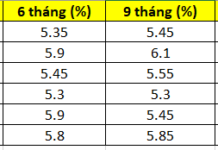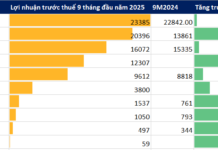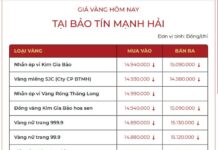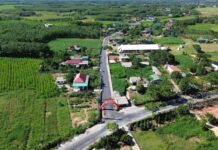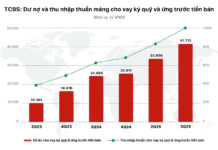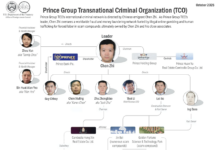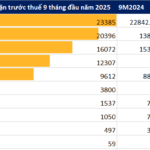As a dynamic region in the world, Vietnam is strategically located in an area with strong trade flows and a highly open economy (over 200%). With 17 Free Trade Agreements already signed and implemented with nearly 70 countries and territories (including most of the world’s major economies, accounting for 90% of global GDP), the country has consistently achieved double-digit growth in export-import and e-commerce. Vietnam is thus recognized as a market with great potential and favorable conditions for the development of logistics services.
THE INDUSTRY IS WORTH AN ESTIMATED $40-42 BILLION PER YEAR
Vietnam has been acknowledged for its significant opportunities to boost the growth of the logistics services industry. This includes continuously expanding and improving transport infrastructure, such as road and air transport, seaports, warehouses, commercial infrastructure, and logistics centers. Accompanying services have also been meeting the diverse and evolving demands of the market in a timely manner.
At the Vietnam Logistics Forum 2024, themed “Free Trade Zones – A Breakthrough Solution to Promote Logistics Growth,” Minister of Industry and Trade, Nguyen Hong Dien, emphasized the critical role of logistics as the “lifeblood” of the national economy. He highlighted the multidimensional importance of logistics and its direct and indirect impact on the country’s import and export turnover. This acknowledgment underscores the vital role of logistics in trade and international commerce.
With an annual growth rate of 14-16%, the logistics industry has been one of the fastest-growing and most stable service sectors in Vietnam in recent years. In 2023, the country’s import and export turnover reached $681 billion, equivalent to 158% of the country’s GDP.
The number of logistics enterprises continues to grow, embracing modernization and enhancing competitiveness. In 2023, 7,919 new logistics companies were established, and Vietnam topped the ASEAN region in the number of businesses licensed for sea transport to and from the United States.
There have been considerable improvements in customs clearance procedures and timeframes for exports. Notably, there has been a boom in e-commerce and logistics for e-commerce in recent years. In 2023, the scale of Vietnam’s e-commerce retail market reached $20.5 billion, an increase of approximately $4 billion (25%) compared to 2022.
The development of Vietnam’s logistics sector is showing positive trends, promoting diverse transport modes and reducing dependence on road transport. There has been a strong emphasis on developing logistics human resources, focusing on three levels of training (university and postgraduate; college and vocational; and short-term) across 49 universities offering logistics programs.

Several international rankings related to Vietnam’s logistics performance have improved. In 2023, the country ranked 43rd out of 139 countries in the World Bank’s Logistics Performance Index, with enhancements in the sub-indices of international shipment efficiency, infrastructure, and customs efficiency. Vietnam has been ranked among the top five leading markets in ASEAN.
In 2024, international organizations ranked Vietnam among the top 10 emerging logistics markets, fourth in the world for the Logistics Opportunity Index, and 43rd for the Logistics Performance Index.
With these achievements, Vietnam is now among the top 10 countries with the fastest-growing e-commerce markets globally (as of the present – according to Statista). These shifts in global and local e-commerce have propelled the Vietnamese logistics industry to enhance its service delivery methods, becoming increasingly professional and efficient.
According to the latest forecast by Standard Chartered, Vietnam will be a key contributor to global trade growth, with export turnover expected to reach $618 billion by 2030, representing an annual growth rate of 7%. Import turnover is projected to reach $578 billion by 2030, increasing at an average rate of 6.9% per year.
THE DA NANG FREE TRADE EXPERIMENT IS A PIONEERING MODEL FOR THE NATION
Recognizing the importance of logistics, Vietnam has issued various mechanisms, policies, and directives to effectively implement solutions to overcome challenges, reduce costs, enhance competitiveness, and create a conducive environment for the development of the logistics services industry.
Logistics infrastructure has been rapidly expanding with significant projects, promoting a reasonable structure and harmonious connectivity between transport modes, reducing costs, and improving production and business efficiency. Notably, there have been breakthroughs in road infrastructure, with the country’s expressway network surpassing 2,000 kilometers. Vietnam is also determined to construct a high-speed North-South railway and connect its railway system with Laos and China.
The airport system has been developing relatively well. Inland waterway capacity has been enhanced with 298 domestic ports, the formation of gateway ports and dedicated wharves linked to industrial parks and industrial centers (including 286 wharves, 95 kilometers of quays, and 25 international routes), the establishment of separate cargo handling areas at airports, and the promotion of investment in logistics centers (currently, there are 69 large and medium-sized centers) with a shift towards new-generation centers applying Industry 4.0 technologies.
However, Minister Nguyen Hong Dien also acknowledged that the development of Vietnam’s logistics services industry has not kept pace with its potential and advantages. Logistics costs remain high, competitiveness is low, and there is a shortage of human resources, particularly high-quality personnel. Additionally, the lack of infrastructure connectivity has been a significant bottleneck hindering the industry’s progress.
Moreover, the industry’s scale relative to Vietnam’s GDP and the global logistics industry (worth $9 trillion) is still limited. Human resources are weak and insufficient, and businesses have not thrived due to the absence of a supportive mechanism. There is also limited linkage between transport modes and warehouses, and logistics infrastructure lags in terms of modernity.
Given Vietnam’s integration into the regional and global economy and its active participation in free trade agreements, leveraging its geo-economic advantages, it is essential to promptly research, propose, and implement the establishment and development of free trade zone models to seize emerging opportunities.
However, up to this point, Vietnam has not established any free trade zones. Minister Nguyen Hong Dien mentioned that the country has been paying attention to and actively studying free trade zones worldwide.
Recently, Da Nang has been approved by the National Assembly to pilot the establishment of a free trade zone, serving as a foundation for policy research and development and paving the way for legalizing free trade zone regulations nationwide.
3 GOALS AND 7 SOLUTIONS
Attending and directing the Forum, Prime Minister Pham Minh Chinh stated that, with the trend of integration, the development of the logistics industry must follow new trends such as digitalization, green growth, circular economy, sharing economy, and knowledge-based economy.

The Prime Minister set forth three goals for the industry’s development, contributing to the country’s broader development objectives: First, reduce logistics costs from 18% to 15% of Vietnam’s GDP by 2025. Second, increase the proportion of the logistics industry in the country’s GDP from 10% to 15% and strive for 20%, while also raising the ratio of Vietnam’s logistics industry to the global logistics industry from 0.4% to 0.5% and aiming for 0.6%. Third, elevate the growth rate of the logistics industry from the current 14-15% per year to 20%.
Concurrently, the Head of the Government presented seven solutions for the industry’s development, considering them as seven breakthroughs to achieve the stated goals and contribute to attaining a two-digit economic growth rate in the coming years.
First, raise awareness of the position, role, and importance of the logistics industry and Vietnam’s central location in the Asia-Pacific region.
Second, create institutional breakthroughs toward openness to promote the industry’s development commensurate with its potential.
Third, construct modern and seamless logistics infrastructure to reduce costs and enhance the competitiveness of products, especially in the aviation, maritime, and high-speed railway sectors.
Fourth, establish intelligent governance and train high-quality human resources for the logistics industry.
Fifth, promote integration and logistics diplomacy while modernizing the domestic logistics industry.
Sixth, build and develop a free trade nation.
Seventh, ensure tight connectivity between transport modes and link with international transport and free trade zones worldwide.
The Prime Minister requested the Ministry of Industry and Trade to take the lead, along with relevant ministries and sectors, in formulating a logistics industry development strategy, a free trade nation development scheme, and proposals for the development of free trade zones in border areas, in coordination with localities to proactively implement these initiatives.
The Vietnam Logistics Forum 2024 (VLF 2024), organized by the Ministry of Industry and Trade in collaboration with the People’s Committee of Ba Ria-Vung Tau province, will take place from December 1-2, 2024, at The Grand Ho Tram Hotel, Phuoc Thuan Ward, Xuyen Moc District, Ba Ria-Vung Tau province.
A Vietnamese E-bike Startup Rides into the Philippines
Introducing the innovative Vietnamese startup that’s revolutionizing the electric motorcycle industry in the Philippines and beyond. With a remarkable localization rate of over 70%, this forward-thinking company is transforming the way we think about electric mobility. But it doesn’t stop there – they’ve also exported an entire ecosystem that enables drivers to fully charge their batteries in just 2 minutes, revolutionizing the driving experience and propelling us into a sustainable future.






